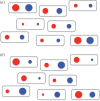Adaptive noise
- PMID: 23902900
- PMCID: PMC3735249
- DOI: 10.1098/rspb.2013.1104
Adaptive noise
Abstract
In biology, noise implies error and disorder and is therefore something which organisms may seek to minimize and mitigate against. We argue that such noise can be adaptive. Recent studies have shown that gene expression can be noisy, noise can be genetically controlled, genes and gene networks vary in how noisy they are and noise generates phenotypic differences among genetically identical cells. Such phenotypic differences can have fitness benefits, suggesting that evolution can shape noise and that noise may be adaptive. For example, gene networks can generate bistable states resulting in phenotypic diversity and switching among individual cells of a genotype, which may be a bet hedging strategy. Here, we review the sources of noise in gene expression, the extent to which noise in biological systems may be adaptive and suggest that applying evolutionary rigour to the study of noise is necessary to fully understand organismal phenotypes.
Keywords: bet hedging; evolution; variation.
Figures

References
-
- Spudich JL, Koshland DE. 1976. Non-genetic individuality: chance in the single cell. Nature 262, 467–471 (doi:10.1038/262467a0) - DOI - PubMed
-
- Lestas I, Vinnicombe G, Paulsson J. 2010. Fundamental limits on the suppression of molecular fluctuations. Nature 467, 174–178 (doi:10.1038/nature09333) - DOI - PMC - PubMed
-
- Munsky B, Neuert G, van Oudenaarden A. 2012. Using gene expression noise to understand gene regulation. Science 336, 183–187 (doi:10.1126/science.1216379) - DOI - PMC - PubMed
-
- Elowitz MB, Levine AJ, Siggia ED, Swain PS. 2002. Stochastic gene expression in a single cell. Science 297, 1183–1186 (doi:10.1126/science.1070919) - DOI - PubMed
-
- Dubnau D, Losick R. 2006. Bistability in bacteria. Mol. Microbiol. 61, 564–572 (doi:10.1111/j.1365-2958.2006.05249.x) - DOI - PubMed
Publication types
MeSH terms
Grants and funding
LinkOut - more resources
Full Text Sources
Other Literature Sources

